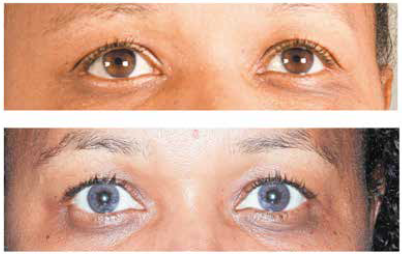Making Brown Eyes Blue
Laser treatment shows promise for permanent iris colour change. Dermot McGrath reports from the French Implant and Refractive Surgery Association (SAFIR) Annual Meeting in Paris.

Dermot McGrath
Published: Monday, July 4, 2022
Laser treatment shows promise for permanent iris colour change.
Dermot McGrath reports from the French Implant and Refractive Surgery Association (SAFIR) Annual Meeting in Paris.
Initial trials of a promising new technology to permanently change iris colour suggest the treatment is safe and effective and will probably be available on the international market in two to three years, according to David Touboul MD, PhD.
“Whether we are in favour of this type of cosmetic procedure or not, the reality is that changing
iris colour is of interest to a sizeable proportion of the population, and this technology will probably arrive on the market in the next few years. As a profession, we need to prepare for it,” Professor Touboul said.
Several proposed techniques change iris colour, including artificial iris implants, corneal tattooing, and cosmetic contact lenses. However, there are significant aesthetic limitations as well as serious safety concerns for some of these techniques, with iris implants and cosmetic contact lenses associated with high rates of corneal decompensation, glaucoma, and infections.
By contrast, the laser depigmentation approach advocated by Strōma Medical Corporation has been over a decade in development, having accumulated convincing safety and efficacy data in animal and human studies to date. “Although we clearly need more long-term studies, the early results are encouraging in terms of effectiveness and safety. This is a credible approach to permanent minimally-invasive iris depigmentation, which avoids a lot of the safety issues we have seen with iris implants and contact lenses,” he said.
Prof Touboul explained the technique works through laser macrophage photoactivation, where a low-fluence, frequency doubled Nd:YAG laser raises and lowers the temperature of the anterior iris pigment multiple times over a period of less than 30 seconds.
“The target is the anterior monocellular layer composed of fibroblasts and melanocytes. The photoactivation stimulates the anterior iris pigment, with controlled heating of the superficial iris pigment, inducing a macrophagic activation that progressively eliminates the pigmented cells in a few weeks,” he said. “As the pigment is removed, light is backscattered by the underlying stromal fibres, resulting in a blue or green iris.”
After initial trials in rabbits, validation studies in humans started with partial iris treatments in Mexico, Costa Rica, and Panama, followed by full iris treatments in Panama in 30 healthy patients with no history of ocular pathology and IOP less than 21 mmHg. Patients were followed up every month for a minimum of one year.
“It took four sessions on average, each spaced at least three weeks apart, to attain the desired result. The results were stable over the follow-up period, and no complications were observed, including quantity and quality of vision, iridocorneal angle, assessment of atrophy and transillumination defects, pupillary health, endothelial loss, iris function, corneal transparency, crystalline lens health, retinal function, and IOP,” he said.
One unexpected side effect of the treatment was an average decrease of 20% in IOP, Prof Touboul said. “The researchers were very surprised by this. One hypothesis is it may be caused by iridial tissue retraction that diffuses to the iridocorneal angle, with perhaps an opening of the trabecular meshwork due to changes in the iris tension,” he said.
Prof Touboul added that a separate company formed by Strōma’s founder is currently exploring the possibility of applying the technology as a treatment for glaucoma.
David Touboul MD, PhD is a Professor of ophthalmology at the University of Bordeaux, France, Head of the National Reference Center for Keratoconus, and President of the SAFIR society. david.touboul@chu-bordeaux.fr
Prof Touboul doesn’t have financial interest in this presentation.

Latest Articles
Towards a Unified IOL Classification
The new IOL functional classification needs a strong and unified effort from surgeons, societies, and industry.
The 5 Ws of Post-Presbyopic IOL Enhancement
Fine-tuning refractive outcomes to meet patient expectations.
AI Shows Promise for Meibography Grading
Study demonstrates accuracy in detecting abnormalities and subtle changes in meibomian glands.
Are There Differences Between Male and Female Eyes?
TOGA Session panel underlined the need for more studies on gender differences.
Simulating Laser Vision Correction Outcomes
Individualised planning models could reduce ectasia risk and improve outcomes.
Need to Know: Aberrations, Aberrometry, and Aberropia
Understanding the nomenclature and techniques.
When Is It Time to Remove a Phakic IOL?
Close monitoring of endothelial cell loss in phakic IOL patients and timely explantation may avoid surgical complications.
Delivering Uncompromising Cataract Care
Expert panel considers tips and tricks for cataracts and compromised corneas.
Organising for Success
Professional and personal goals drive practice ownership and operational choices.